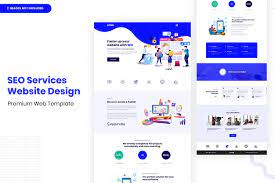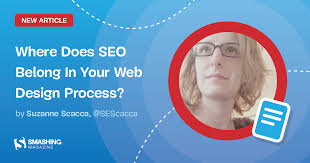Web Design and SEO: A Powerful Combination for Online Success
In today’s digital era, having a visually appealing and user-friendly website is crucial for any business. However, a beautiful website alone is not enough to drive traffic and generate leads. That’s where the power of Search Engine Optimization (SEO) comes into play. By combining effective web design with SEO strategies, businesses can create a winning online presence that attracts both users and search engines.
Web design encompasses various elements such as layout, color scheme, typography, and overall user experience. It aims to create an aesthetically pleasing website that engages visitors and encourages them to explore further. A well-designed website not only captivates users but also instills trust and credibility in your brand.
However, no matter how visually stunning your website may be, it won’t serve its purpose if it doesn’t rank well on search engine results pages (SERPs). This is where SEO steps in. SEO involves optimizing your website’s content, structure, and technical aspects to improve its visibility on search engines like Google.
When web design and SEO work hand in hand, the results can be truly remarkable. Here are some key benefits of integrating web design with SEO:
- Enhanced User Experience: A well-designed website with intuitive navigation and fast loading times improves user experience. By optimizing the site’s structure and ensuring easy accessibility to relevant information, you provide visitors with a seamless browsing experience.
- Improved Search Engine Rankings: Search engines consider various factors when ranking websites. Effective web design practices such as mobile responsiveness, clean code, optimized images, and proper use of HTML tags contribute to better search engine rankings.
- Increased Organic Traffic: Appearing on the first page of search results significantly increases organic traffic to your website. When your web design is optimized for SEO, it becomes easier for search engines to crawl and index your pages accurately.
- Higher Conversion Rates: A visually appealing website combined with persuasive content and clear call-to-action buttons can lead to higher conversion rates. When users find your website trustworthy, they are more likely to engage with your brand and convert into customers.
- Better Brand Visibility: An SEO-friendly website design ensures that your brand is visible to a wider audience. By targeting relevant keywords and optimizing meta tags, headings, and URLs, you increase the chances of appearing in search results when users search for products or services related to your business.
To achieve the best results, it is essential to involve both web designers and SEO specialists from the early stages of website development. Collaboration between these two disciplines ensures that the design elements align with SEO requirements without compromising on visual appeal or user experience.
In conclusion, web design and SEO go hand in hand in creating a successful online presence. By combining visually appealing designs with effective optimization techniques, businesses can attract more visitors, improve search engine rankings, and ultimately drive conversions. Embrace the power of this dynamic duo to unlock the full potential of your website in today’s competitive digital landscape.
“Enhancing Website Aesthetics and Usability: Tips for a User-Friendly Interface”
3. “Decoding SEO: Boosting Your
- What is web design and why is it important for my business?
- How can I make my website visually appealing and user-friendly?
- What is SEO and how does it impact my website’s visibility on search engines?
- What are the key elements of on-page SEO optimization?
- How can I improve my website’s loading speed for better user experience and SEO?
- Is mobile responsiveness important for web design and SEO? Why?
- How do I choose the right keywords for optimizing my website’s content?
- Can you explain the difference between organic SEO and paid advertising (PPC)?
What is web design and why is it important for my business?
Web design refers to the process of creating and arranging the visual elements, layout, and functionality of a website. It involves the use of various design principles and techniques to deliver an engaging user experience. Web design is crucial for businesses as it plays a vital role in shaping their online presence. A well-designed website not only captures visitors’ attention but also communicates the brand’s message effectively. It establishes credibility, builds trust, and enhances user satisfaction. Moreover, web design influences search engine optimization (SEO) efforts by ensuring that the site is structured, responsive, and optimized for better visibility on search engine results pages (SERPs). In today’s digital landscape, where users have high expectations, having a professionally designed website can give your business a competitive edge and help you attract and retain customers.
How can I make my website visually appealing and user-friendly?
Creating a visually appealing and user-friendly website requires careful attention to design elements and user experience. Firstly, focus on a clean and uncluttered layout that guides users through the site effortlessly. Incorporate visually pleasing color schemes that align with your brand identity and evoke positive emotions. Choose fonts that are easy to read and maintain consistency throughout the site. Additionally, optimize images to ensure fast loading times without compromising quality. Implement intuitive navigation menus and clear call-to-action buttons to help users find what they’re looking for easily. Lastly, prioritize mobile responsiveness to ensure seamless browsing across different devices. By combining these design principles with a user-centric approach, you can make your website both visually appealing and user-friendly, enhancing engagement and driving success.
What is SEO and how does it impact my website’s visibility on search engines?
SEO, or Search Engine Optimization, is the practice of optimizing your website to improve its visibility on search engine results pages (SERPs). It involves various strategies and techniques that aim to make your website more appealing to search engines like Google. By implementing SEO best practices, such as keyword research, on-page optimization, link building, and technical improvements, you can increase your website’s chances of ranking higher in search results. The higher your website ranks, the more visible it becomes to potential visitors. Improved visibility not only drives organic traffic to your site but also enhances brand exposure and increases the likelihood of attracting quality leads. In short, SEO plays a vital role in boosting your website’s visibility on search engines and ultimately driving valuable organic traffic to your online presence.
What are the key elements of on-page SEO optimization?
On-page SEO optimization involves various key elements that are crucial for improving a website’s visibility and ranking on search engine results pages. These elements include optimizing meta tags (such as title tags and meta descriptions) to accurately describe the content of each page, incorporating relevant keywords in strategic locations throughout the content, ensuring proper heading structure (H1, H2, etc.), optimizing URL structure for readability and keyword inclusion, optimizing images with descriptive alt tags, creating unique and engaging content that provides value to users, improving website loading speed for better user experience and search engine crawling, implementing internal linking to establish a logical site structure and facilitate navigation, and ensuring mobile responsiveness to cater to the increasing number of mobile users. By focusing on these key elements of on-page SEO optimization, businesses can enhance their website’s performance and increase its chances of ranking higher in search engine results.
How can I improve my website’s loading speed for better user experience and SEO?
Improving your website’s loading speed is crucial for both user experience and SEO. A slow-loading website not only frustrates visitors but also negatively impacts your search engine rankings. To enhance loading speed, start by optimizing images and reducing their file sizes without compromising quality. Minify CSS and JavaScript files to reduce their size, and leverage browser caching to store certain elements locally, decreasing load times for returning visitors. Additionally, consider using a content delivery network (CDN) to distribute your website’s content across multiple servers worldwide, ensuring faster access for users regardless of their location. Compressing files, optimizing server response times, and utilizing efficient coding practices are other effective strategies to boost loading speed. By prioritizing the need for a fast-loading website, you can provide a seamless user experience while improving your SEO performance.
Is mobile responsiveness important for web design and SEO? Why?
Yes, mobile responsiveness is extremely important for web design and SEO. With the increasing use of smartphones and tablets, more and more users are accessing websites on their mobile devices. If a website is not optimized for mobile viewing, it can lead to a poor user experience, high bounce rates, and lower search engine rankings. Search engines like Google prioritize mobile-friendly websites in their search results, as they aim to provide the best user experience to their users. By ensuring that your website is mobile responsive, you not only cater to the needs of your mobile audience but also enhance your chances of ranking higher in search engine results pages. Mobile responsiveness is therefore a crucial aspect of web design and SEO that cannot be overlooked in today’s mobile-driven world.
How do I choose the right keywords for optimizing my website’s content?
Choosing the right keywords for optimizing your website’s content is a crucial step in SEO. Start by understanding your target audience and their search intent. Conduct thorough keyword research using tools like Google Keyword Planner or SEMrush to identify relevant and high-volume keywords related to your business. Consider long-tail keywords that are more specific and have less competition. Focus on selecting keywords that align with your content and reflect what users are searching for. It’s also important to analyze the competitiveness of keywords and choose ones that strike a balance between search volume and competition. Regularly monitor keyword performance and make adjustments as needed to ensure your website’s content remains optimized for maximum visibility and organic traffic.
Can you explain the difference between organic SEO and paid advertising (PPC)?
Understanding the Difference: Organic SEO vs. Paid Advertising (PPC)
One frequently asked question in the realm of web design and SEO is the distinction between organic SEO and paid advertising, often referred to as Pay-Per-Click (PPC). Organic SEO focuses on optimizing a website’s content, structure, and technical aspects to improve its visibility on search engine results pages (SERPs) naturally. It involves strategies such as keyword research, on-page optimization, link building, and creating high-quality content. On the other hand, paid advertising or PPC involves running targeted ads on search engines or other platforms. Advertisers pay a fee each time their ad is clicked. While organic SEO aims to drive long-term organic traffic through improved rankings, PPC provides immediate visibility by placing ads at the top of search results. Both approaches have their merits and can be combined for a comprehensive digital marketing strategy tailored to specific business goals and budgets.




